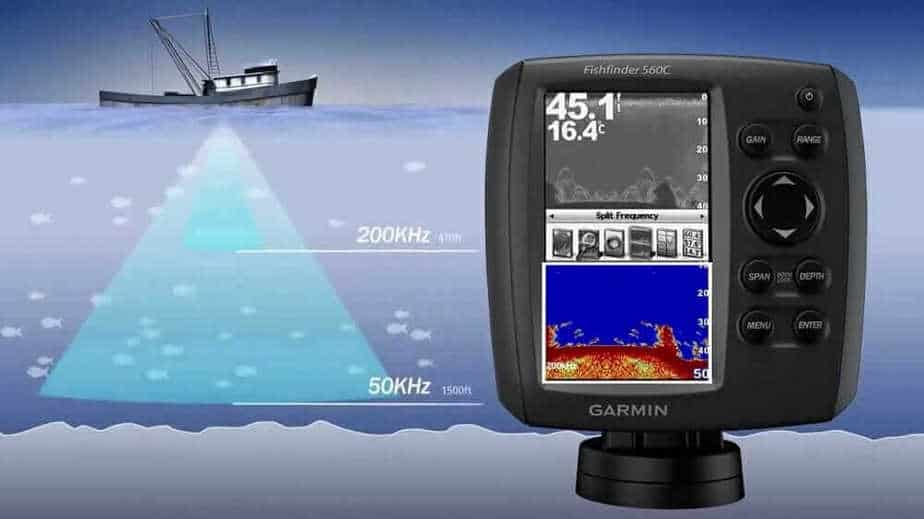The fish finder device is capable of indicating the presence of fish, including the type of fish present in an area. This device is an essential tool that must be present in the arsenal of any angler who wishes to reel in more fish. Regarding a fish finder, there are few questions some anglers are yet to find satisfactory answers to, questions like “How far out does a fish finder locate fish?”, and so on. Yes, we are aware that a fish finder is used to locate the presence of fish, but do you know the max range at which a fish finder device can identify fish? If you don’t, then sit back, relax, and meticulously glance through this write-up to get the best answer to that question. Before answering the question, it’s paramount we brief you a little on a little of what the fish finder device is.
How Far Out Does A Fish Finder Locate Fish?
A fish finder is regarded as a device designed to indicate the presence of fish underneath the water, and this device also helps to measure water depth. Aside from the functions as mentioned above, a fish finder is also capable of revealing underwater objects, such as rocks, wreckage, and school of fish that we can’t see with our bare eyes. Each year different types of new innovative fish finders are flooding the market. Present in the fish finder market are the cheap fish finders and the expensive ones, therefore, it’s best you go for that which properly suits your budget.
Having gotten little insight on what a fish finder device is, it best we delve into the real issue.
Learn more if the Fishfinders can be detected by fish.
Range Of A Fish Finder:
Frequency of a particular fish finder plays a significant role in determining how far a fish finder can locate fish. There are two types of frequency, the infrasonic (low frequency) and the ultrasonic (high frequency).
Ultrasound frequency utilized by a fish finder usually ranges from 15KHz to around 200KHz. But, the majority of the modern fish finder made for recreational craft makes use of 50KHz and 200KHz. Such fish finders you find in the market incorporate electronic circuitry that can convey and receive ultrasound in the frequencies mentioned above. A transducer mounted on the bottom of the craft can also be configured to control the two frequencies.
Nevertheless, fish finders for professional use, e.g., those utilized by commercial anglers can use other frequencies, like 15, 22, 45, 38, 50, 75, 88, 68, 107, 150, 200 KHz. There exist several unique and reliable fish finders that makes use of frequency of 400 kHz, but it is an uncommon occurrence. As earlier stated, there exist a panoply of configurable frequencies for fish finders for fishery vessels, and a fish finder usually adopts a combination of two frequencies (low and high frequencies).
This aspect of the frequencies hinges on the intending aim of the fish finder, which is, inter alia, searching for certain species of fish; understand the condition of the sea bed, carrying out an extensive area search with a search angle of 90 degrees at a go, carrying out a thorough search for school of fish, preventing interference with other fish finders around, and detecting school of fish that provides feeble echo returns. The searchable region and the range in which a fish finder can locate fish all hinges on the frequency adopted. On the contrary, high-frequency ultrasound is ideal for a thorough search in deep water, while a low-frequency search is suitable for general searches in a broad area including searching deep water.
Commercial anglers also adopt these characteristics when fishing. They carry out a search using low frequency (e.g., 15KHz) beams first to understand the general location of the school of fish around the boat. Afterward, they narrow down the search area for a school of fish by adopting high-frequency beam (e.g., 200KHz), to find the precise location of a school of fish and operate the boat so that it is directly above the targeted school of fish.
Detection Range:
Like earlier stated, the detection range of a fish finder device hinges solely on the frequency used for ultrasound transmission. In principle, the higher the ultrasound frequency, the shorter the propagation range of the fish finder. This means that a fish finder with a higher ultrasound frequency will have a shorter fish detecting range, unlike a fish finder that comes with a lower ultrasound frequency. The wavelength of a high frequency is small, which results in more detailed searches, but it reduces significantly while moving underwater. Low-frequency ultrasound is described by its long wavelength, wider directivity angle and a high rate of tolerance directed towards underwater attenuation, therefore giving rise to wide-area-searches in deeper water.
In summary, you can select low frequency if you are fishing in deep water and increase the frequency if you are carrying out a thorough search in shallow water. Also, when adopting low-frequency ultrasound, you may be able to carry out more accurate deep-water searches by including an alternative power adapter, which increases the power of the transmitter to a little kilowatt. You should note that when utilizing the power adapter, you will require a dedicated transducer that is capable of handling a higher transmitter strength.
The difference in searchable range between low and high-frequency ultrasound:
Basically, with fish finders that come with reduced frequency (50 kHz) ultrasound, you can carry out a deep-water search, while with a fish finder that comes with high frequency (200KHz) ultrasound, the searchable depth is not that deep. In a nutshell, the range in which a fish finder can detect the presence of fish, all depends on the frequency of the fish finder, and each fish finder present in the market comes with various frequency.
